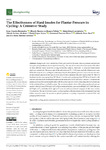Mostrar o rexistro simple do ítem
The Effectiveness of Hard Insoles for Plantar Pressure in Cycling: A Crossover Study
| dc.contributor.author | Losa Iglesias, Marta Elena | |
| dc.contributor.author | Becerro-de-Bengoa-Vallejo, Ricardo | |
| dc.contributor.author | Casado-Hernández, Israel | |
| dc.contributor.author | Soriano-Medrano, Alfredo | |
| dc.contributor.author | López-López, Daniel | |
| dc.contributor.author | Navarro Flores, Emmanuel | |
| dc.contributor.author | Pérez-Boal, Eduardo | |
| dc.contributor.author | Martínez-Jiménez, Eva María | |
| dc.date.accessioned | 2023-12-26T09:25:25Z | |
| dc.date.available | 2023-12-26T09:25:25Z | |
| dc.date.issued | 2023-07-08 | |
| dc.identifier.citation | Casado-Hernández, I.; Becerro-de-Bengoa-Vallejo, R.; Losa-Iglesias, M.E.; Soriano-Medrano, A.; López-López, D.; Navarro-Flores, E.; Pérez-Boal, E.; Martínez-Jiménez, E.M. The Effectiveness of Hard Insoles for Plantar Pressure in Cycling: A Crossover Study. Bioengineering 2023, 10, 816. https://doi.org/10.3390/ bioengineering10070816 | es_ES |
| dc.identifier.uri | http://hdl.handle.net/2183/34620 | |
| dc.description.abstract | [Abstract] Background: Hard insoles have been proposed to decrease plantar pressure and prevent foot pain and paresthesia due to repetitive loading. The aim of this research was to analyze the effect of three different hard insoles in cycling on healthy subjects. Methods: A crossover randomized trial was carried out. The mean age of the subjects was 35 3.19 years, and all of them were men. While the subjects were cycling on a stationary bicycle, their plantar pressure was recorded with nine in-shoe sensors placed in nine specific foot areas to test a standard ethylene-vinyl-acetate 52 Shore A hardness insole, a polypropylene 58 Shore D insole, and a polypropylene 580 Shore D insole with selective aluminum 60 HB Brinell hardness in the metatarsal head and hallux. Results: The maximum plantar pressure decreased significantly with the polypropylene insole containing selective aluminum in the metatarsal head and hallux areas. The maximum plantar data of the polypropylene aluminum insole in the M2 area (5.56 kgF/cm2), fifth metatarsal styloid process (6.48 kgF/cm2), M3–M4 area (4.97 kgF/cm2), and hallux (8.91 kgF/cm2) were of particular interest compared to the other insoles. Conclusions: The use of insoles made of polypropylene with aluminum in the metatarsal head and hallux areas decreases the maximum plantar pressure in cycling compared to standard EVA and polypropylene insoles. | es_ES |
| dc.language.iso | eng | es_ES |
| dc.publisher | MDPI | es_ES |
| dc.relation.uri | https://doi.org/10.3390/ bioengineering10070816 | es_ES |
| dc.rights | Atribución 3.0 España | es_ES |
| dc.rights.uri | http://creativecommons.org/licenses/by/3.0/es/ | * |
| dc.subject | Cycling | es_ES |
| dc.subject | Plantar pressure | es_ES |
| dc.subject | Foot insole | es_ES |
| dc.subject | Metatarsal head | es_ES |
| dc.subject | in-shoe | es_ES |
| dc.subject | Ciclismo | es_ES |
| dc.subject | Presión plantar | es_ES |
| dc.subject | Plantilla | es_ES |
| dc.subject | Cabeza del metatarso | es_ES |
| dc.subject | Parte interna del calzado | es_ES |
| dc.title | The Effectiveness of Hard Insoles for Plantar Pressure in Cycling: A Crossover Study | es_ES |
| dc.type | info:eu-repo/semantics/article | es_ES |
| dc.rights.access | info:eu-repo/semantics/openAccess | es_ES |
| UDC.journalTitle | Bioengineering | es_ES |
| UDC.volume | 10 | es_ES |
| UDC.startPage | 816 | es_ES |
Ficheiros no ítem
Este ítem aparece na(s) seguinte(s) colección(s)
-
GI-UDISAP - Artigos [196]






